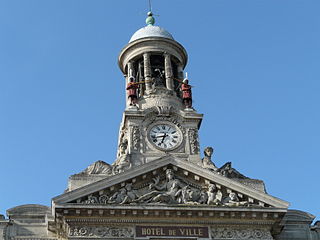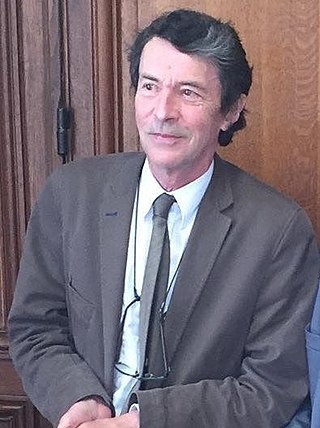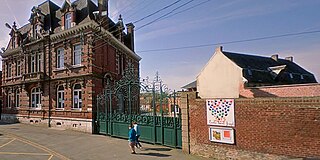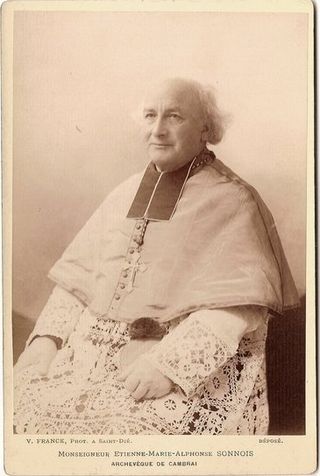
Cambrai, formerly Cambray and historically in English Camerick or Camericke, is a city in the Nord department and in the Hauts-de-France region of France on the Scheldt river, which is known locally as the Escaut river.

The arrondissement of Cambrai is an arrondissement of France in the Nord department in the Hauts-de-France region. It has 116 communes. Its population is 162,045 (2016), and its area is 901.6 km2 (348.1 sq mi).
The following is a list of the 41 cantons of the Nord department, in France, following the French canton reorganisation which came into effect in March 2015:

Briastre is a commune in the Nord department in northern France.

Caudry is a commune in the Nord department in northern France. Its inhabitants are called the 'Caudrésiens'. The town is mostly known as the Capital City of French Lace. Caudry station has rail connections to Douai, Cambrai, Paris, Lille and Saint-Quentin.
Ludovic Liron is a French football defender who played for clubs in French Ligue 1 and Ligue 2.

Saint-Souplet is a commune in the Nord department in northern France.

Saint-Python is a commune in the Nord department in northern France. It was named after Piatus of Tournai. Its inhabitants are called Saint-Piatiens or Piatonnais.

Villers-Plouich is a commune in the Nord department in northern France, situated 14 km south-west of the town of Cambrai.

François-Xavier Villain was a member of the National Assembly of France. He represented the Nord department, from 2002 to 2017 and is a member of Arise the Republic, a small Gaullist party led by Nicolas Dupont-Aignan. He is also mayor of Cambrai.
The canton of Caudry is an administrative division of the Nord department, northern France. It was created at the French canton reorganisation which came into effect in March 2015. Its seat is in Caudry.

Jules Deloffre was a French racing cyclist. He rode in fourteen editions of the Tour de France between 1908 and 1928, finishing in seven of them. Throughout his career he was nicknamed 'The Acrobat'. During the First World War, he served in the infantry under Colonel Driant in Verdun and a street was named after him in Le Cateau-Cambrésis where he is considered a local hero.

Julien Masson is a French professional footballer who plays as a midfielder for the French club Valenciennes FC in the Ligue 2.

Mulquinerie, is a landmark of French sartorial heritage and high craftsmanship, is the art of weaving and trading fine fabrics composed exclusively of linen: whether plain flax cloth, 'linon' or batiste. A 'mulquinier' was the artisan textile designer and weaver as well as the merchant of canvases. The mulquiniers were not only a subcategorization of the tisserand(e) artists (hand loom weavers; French pronunciation: [tisʀɑ̃]) but were also the traders of their own craft. This activity was predominantly developed within villages as a substantial rural proto-industry, hence mulquiniers working on métiers à tisser in their home' basement while breathing from "bahottes" or "blocures" to obtain the most propitious humidity levels.

Institution Saint Michel: Collège and Lycée is a Catholic secondary school with boarding facilities located in Solesmes, France. Founded in 1924 by the Roman Catholic Archdiocese of Cambrai constituted in 580, it is now also contractually regulated by the Academy of Lille, a ramification of the French Ministry of National Education, Higher Education and Research. As of 2018, it welcomes within centuries-old châteauesque edifices around a thousand students from nearly a hundred municipalities within a radius extending twenty kilometers.

École Saint-Joseph is a French Catholic school ruled by the Ministry of National Education and based in Solesmes, Nord department, within the Hauts-de-France bordering Belgium. It was founded in 1892 by the Roman Catholic Archdiocese of Cambrai of the Latin Rite and is attached to the Cambrai - Le Cateau-Cambrésis educational district contractually regulated by Lille. It is part of the Saint-Pierre consortium comprising schools in three other cities. The manor is a regional landmark due to its typical architecture. As of September 2018, it has more than three hundred pupils supervised by a staff of around forty agents.

Etienne-Marie-Alphonse Sonnois, born December 10, 1828 in Lamargelle (Saint-Seine-l'Abbaye) in the Côte-d'Or in eastern France, died 7 February 1913 (aged 84) in Cambrai within the Hauts-de-France region on the Scheldt river, was a French Catholic bishop, bishop of Saint-Dié from 1889 to 1893 then archbishop of Cambrai de 1893 to 1913.

The Musée des Beaux-Arts de Cambrai, also known as the Musée de Cambrai, is the main museum in the northern French city of Cambrai. It holds collections of archaeology, visual arts and local heritage. Of particular note among the holdings are works by Flemish and Dutch painters of the 17th century and French artists of the 19th and 20th centuries; a collection of osteoarchaeology which is unique in France; and a copy of a plan-relief of the city as it appeared in the reign of Louis XIV.

Laurent Degallaix is a French politician. A member of the Radical Party, then the Radical Movement and finally the Horizons movement, he has been mayor of Valenciennes since 2012 and a member of parliament from 2014 to 2017.
















